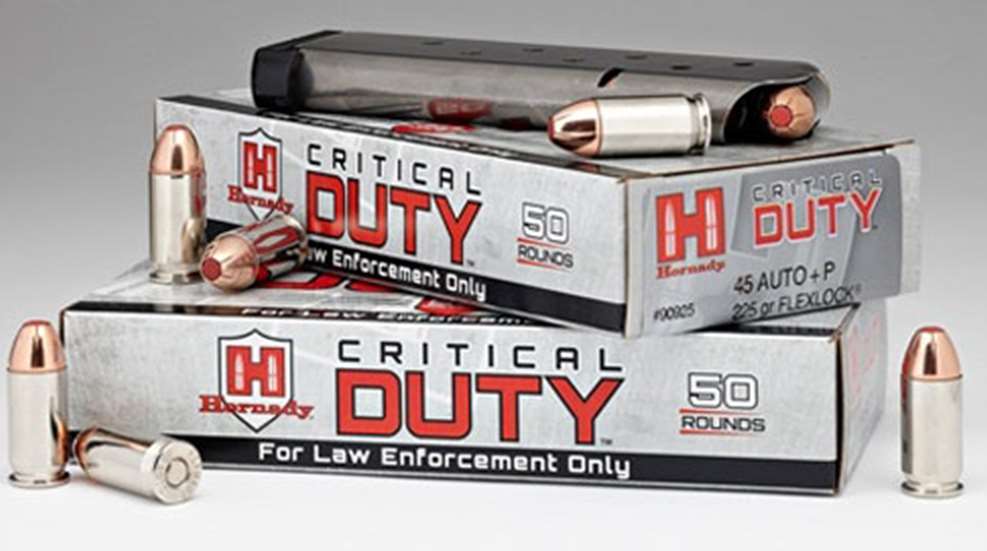
Hornady's new Critical Duty loads for the 9 mm and .40 S&W were specifically designed for law enforcement, engineered to meet the FBI's stringent qualifications for service ammunition. These tests put emphasis on a bullet's ability to pass through specific intermediate barriers, expand and still deliver at least 12 inches of penetration.
In the world of firearms, I doubt there's a subject more controversial than defensive handgun ammunition. Before delving into the specifics of Hornady's Critical Duty and Critical Defense loads, you need to understand something about terminal ballistics. Defensive handguns are very inadequate at stopping bad guys. The bullets make small holes and damage small amounts of tissue. Like Gunsite instructor Charlie McNeese says, "Humans are hydraulic machines; they run on fluid." All you can really hope a defensive handgun bullet will do is let a lot of fluid out in a hurry.
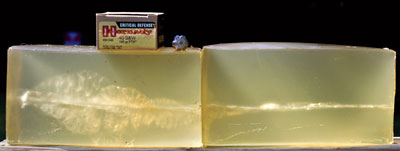
The problem with this approach is that even with a big leak, a bad guy can operate long enough to return the favor. It might come down to who leaks the most, the soonest. There are really only three factors that contribute to wounding with any defensive handgun bullet: expansion, penetration and velocity. In other words, a bullet's effectiveness is determined by how big a hole it makes, how deep it penetrates and how fast it hits.
You could say, all else being equal, the bullet that expands the most is better. But, you could also say the same about the bullet that penetrates the deepest or the one going the fastest. It's easy to make a bullet go fast, penetrate deep or expand wide, and these three factors are what bullet engineers must balance when designing any defensive handgun load. What balance is best?
Hornady has its opinion on balance, and the balance the company achieved with its Critical Duty ammunition meets or exceeds FBI standards. Hornady reports that when Critical Duty ammo is subjected to the FBI's intermediate barrier tests—auto glass, heavy clothing, plywood, drywall and sheet steel—you can expect at least 13 inches of penetration and expansion of between 1.2 and 1.6 times the bullet's original diameter.
This is relatively common performance for most modern law enforcement loads. The difference is most use bonded bullets, while Hornady's Critical Duty loads are not bonded. The Critical Duty utilizes a projectile called the FlexLock bullet, which is the latest in the evolution of Hornady's XTP bullet that has been loaded in defensive handgun ammunition for more than 20 years.
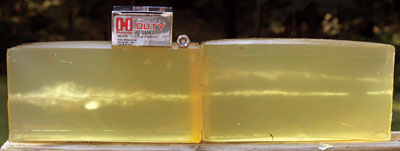
The jacketed-hollow-point (JHP) XTP bullet has a lead core and a copper jacket.The jacket gets thicker the closer it gets to the bullet's base. XTPs have a reputation of moderate expansion, high weight retention and deep penetration. The weak link of standard JHP bullets like the XTP is the hollow-point cavity must fill with something uncompressible, like bodily fluids, during penetration. If not, or if the hollow point gets clogged with barrier material, this hydraulic reaction—expansion—cannot occur.
In 2009 Hornady found a solution with what it calls the FlexTip (FTX) bullet. The FTX was essentially an XTP with a polymer ball inserted inside the hollow-point cavity. It's loaded in Hornady's Critical Defense ammo and circumvented the problem of hollow points clogging, because the bullet already had an uncompressible material inside the nose cavity. When the bullet impacted something, force on the bullet's nose pressed the polymer ball out against the sides of the cavity and caused the bullet to expand. It sort of mimicked Federal's Guard Dog EMFJ (expanding full-metal jacket) and Cor-Bon's Pow'RBall loads.
With Critical Defense, Hornady also provided an option for civilians looking for effective defensive handgun ammunition with controllable recoil. Since the expansion of the FTX bullet was not so dependent on velocity, Hornady chose lighter-weight bullets. This reduced recoil and made compact handguns easier to shoot. The lighter bullets at moderate velocities also reduced concerns of overpenetration.
Now remember, building defensive handgun ammunition is a balancing act. With Critical Defense, Hornady achieved a certain balance of velocity, expansion and penetration for a wide range of cartridges—.22 WMR to .45 Colt—which had yet to be offered by any other manufacturer.
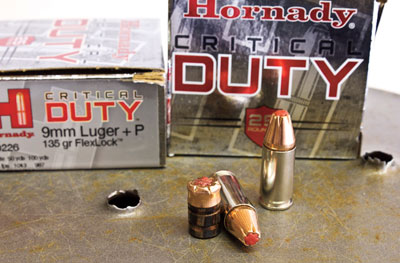
Although there are subtle differences between the Critical Defense FTX bullet and the newer Critical Duty FlexLock bullet, the major difference is the jacket of the FlexLock bullet is mechanically locked to the core. About midway along the bourelet—the section of the bullet which is of caliber diameter—there is a thick band which protrudes into the core material. This band holds the core in the jacket, preventing separation potentially induced by tough intermediate barriers like auto glass.
Does this mean that Hornady's Critical Duty ammunition is the best option when it comes to stopping bad guys? Is it better than Hornady's Critical Defense ammo? Nope. It just means Hornady has found a different balance, one capable of exceeding or meeting the FBI requirements. But, as with most things, there's more to the story.
Bullet weights for the three Critical Duty loads are odd: 135 grains for 9 mm and 175 grains for .40 S&W. Also, like with Critical Defense loads, Critical Duty ammunition is loaded in nickel-plated cases, which increases feeding and extraction reliability. There's also something not so obvious: The core of the FlexLock bullet has a high antimony content, which makes it harder than pure lead.
You can view the specifications and FBI test results for all three Critical Duty loads on the Hornady website. If you're a law enforcement agency, this is all good info. If you're just an average guy like me, looking for a good load to stuff in the magazine of your carry gun, the important question might be, "What is best for carry in a defensive handgun, Critical Duty or Critical Defense?"
I'm a trust-but-verify kind of guy, so I conducted my own testing of both Critical Defense and Critical Duty ammo using 10-percent ordnance gelatin, denim fabric and 16-gauge stainless steel. (The FBI tests specify two layers of hot-rolled 20-gauge steel separated by 3 inches.) I also used long- and short-barreled 9 mm pistols for the tests to see how the bullets would react to reduced velocities. The first thing I found was the velocities of both were very consistent—as consistent, if not more so, than any handgun ammunition I've tested. When testing advanced to terminal performance, things got really interesting.
On average and through all barriers, the Critical Duty loads penetrated 25 percent deeper than the Critical Defense loads. However, the Critical Defense loads showed 9 percent more expansion. Interestingly, in my four layers of denim tests, the 9 mm Critical Defense load expanded more than the Critical Duty load. When both .40 S&W loads were fired through the four layers of denim, the Critical Duty load did not expand at all, and the Critical Defense load expanded well, but penetration was limited.
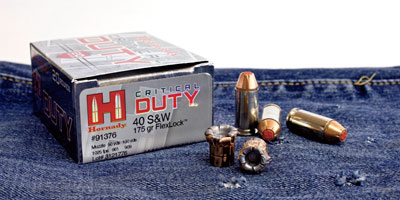
As for the steel tests, it would appear one layer of 16-gauge stainless steel is much harder on bullets than two layers of 20-gauge hot-rolled steel. None of the bullets expanded and all penetrated about 2 feet.
The Critical Duty loads did much better through two layers of denim than four. The 9 mm load expanded to 0.490 inch and the .40 S&W to 0.515 inch. The Critical Defense loads performed so well through four layers of denim, they were not subjected to the two-layer tests.
What does all this data tell us? First, understand I did not try to duplicate the FBI tests. My goal was to see the terminal performance differences between Critical Defense and Critical Duty ammo. Also, 200 rounds of each load were fired through the test handguns, and there were no hiccups. Accuracy was totally sufficient for head shots on zombies at any handgun range.
Which should you choose for your defensive handgun? If you don't mind recoil, like more penetration and think you might have to deal with bad guys shooting at you from behind barriers, go with Critical Duty. If you prefer wider expansion and less recoil, choose Critical Defense, which is optimized for use in short-barreled, compact handguns. For what it's worth, the Kimber Solo Carry I used for the tests is my wife's. When she carries it, it's loaded with Hornady Critical Defense ammo. Poke a bad guy in the solar plexus with any of these, and I'm betting he will leak and the coroner won't be able to tell if your handgun was loaded with Critical Duty or Critical Defense.
Hornady Critical Defense vs. Critical Duty Velocities
|
Load |
Gun |
AV |
MD |
SD |
|
Critical Defense 9 mm 115-grain |
K |
1,019 |
22 |
8 |
| Critical Duty 9 mm +P 135-grain |
K |
1,023 |
21 |
10 |
| Critical Defense 9 mm 115-grain |
T |
1,077 |
24 |
10 |
| Critical Duty 9 mm +P 135-grain |
T |
1,080 |
28 |
11 |
| Critical Defense .40 S&W 165-grain |
S |
1,116 |
55 |
28 |
| Critical Duty .40 S&W 175-grain |
S |
990 |
38 |
12 |
NOTES: Average velocity (AV), maximum velocity deviation (MD) and standard velocity deviation (SD) are all reported in fps and were established by firing 10 shots over a Shooting Chrony positioned 10 feet from the muzzle. Temperature: 81 degrees Fahrenheit. Guns are indicated as: Kimber Solo Carry with a 2.7-inch barrel (K), Smith & Wesson M&P with a 4.25-inch barrel (S) and TriStar C-100 with a 3.9-inch barrel (T).
Gelatin Testing
|
Load |
Gun |
Barrier |
VEL |
PEN |
EXP |
RW |
| Critical Defense 9 mm 115-grain |
K |
None |
1,040 |
13.5 |
.535 |
115 |
|
T |
None |
1,066 |
13.5 |
.544 |
115 |
|
|
T |
4 x denim |
1,084 |
14.5 |
.556 |
115 |
|
|
T |
16-gauge steel |
1,120 |
26.5 |
.355 |
135 |
|
| Critical Duty 9 mm +P 135-grain |
* |
None |
1,115 |
14.0 |
.581 |
135 |
|
K |
None |
1,052 |
19.0 |
.498 |
135 |
|
|
T |
None |
1,086 |
17.5 |
.512 |
135 |
|
|
T |
2x denim |
1,082 |
19.0 |
.490 |
135 |
|
|
T |
4x denim |
1,082 |
17.5 |
.490 |
134 |
|
|
T |
16-gauge steel |
1,102 |
25.5 |
.355 |
135 |
|
| Critical Defense .40 S&W 165-grain |
S |
None |
1,124 |
15.5 |
.624 |
164 |
|
S |
4x denim |
1,086 |
8.8 |
.512 |
164 |
|
|
S |
16-gauge steel |
1,086 |
24.0 |
.400 |
165 |
|
| Critical Duty .40 S&W 175-grain |
* |
None |
1,025 |
13.5 |
.577 |
174 |
|
S |
None |
994 |
17.5 |
.512 |
173 |
|
|
S |
2x denim |
992 |
20.0 |
.515 |
173 |
|
|
S |
4x denim |
998 |
25.0 |
.400 |
175 |
|
|
S |
16-gauge steel |
1,006 |
26.0 |
.400 |
175 |
Velocity (VEL) measured in fps and was recorded 4 feet from the muzzle prior to gel-block entry. Gel blocks were placed at 3 feet and penetration (PEN) was measured in inches to the nearest quarter inch. Expansion (EXP) measurements represent the average expanded diameter of the recovered bullet in inches and the recovered bullet weight (RW) was rounded up to the nearest grain. * = Advertised performance per Hornady website. Temperature: 83 degrees Fahrenheit. Guns are indicated as: Kimber Solo Carry with a 2.7-inch barrel (K), Smith & Wesson M&P with a 4.25-inch barrel (S) and TriStar C100 with a 3.9-inch barrel (T).
Hornady Critical Duty Accuracy Results
|
Load |
Group Size |
||
|
Smallest |
Largest |
Average |
|
| Critical Duty 9 mm +P 135-grain Flexlock |
2.94 |
5.31 |
4.00 |
| Critical Duty .40 S&W 175-grain Flexlock |
2.23 |
4.75 |
3.68 |
Accuracy measured in inches for five, five-shot groups from a sandbag rest at a distance of 25 yards. A Smith & Wesson M&P was used for testing the .40 S&W load and a TriStar C-100 for the 9 mm.






































